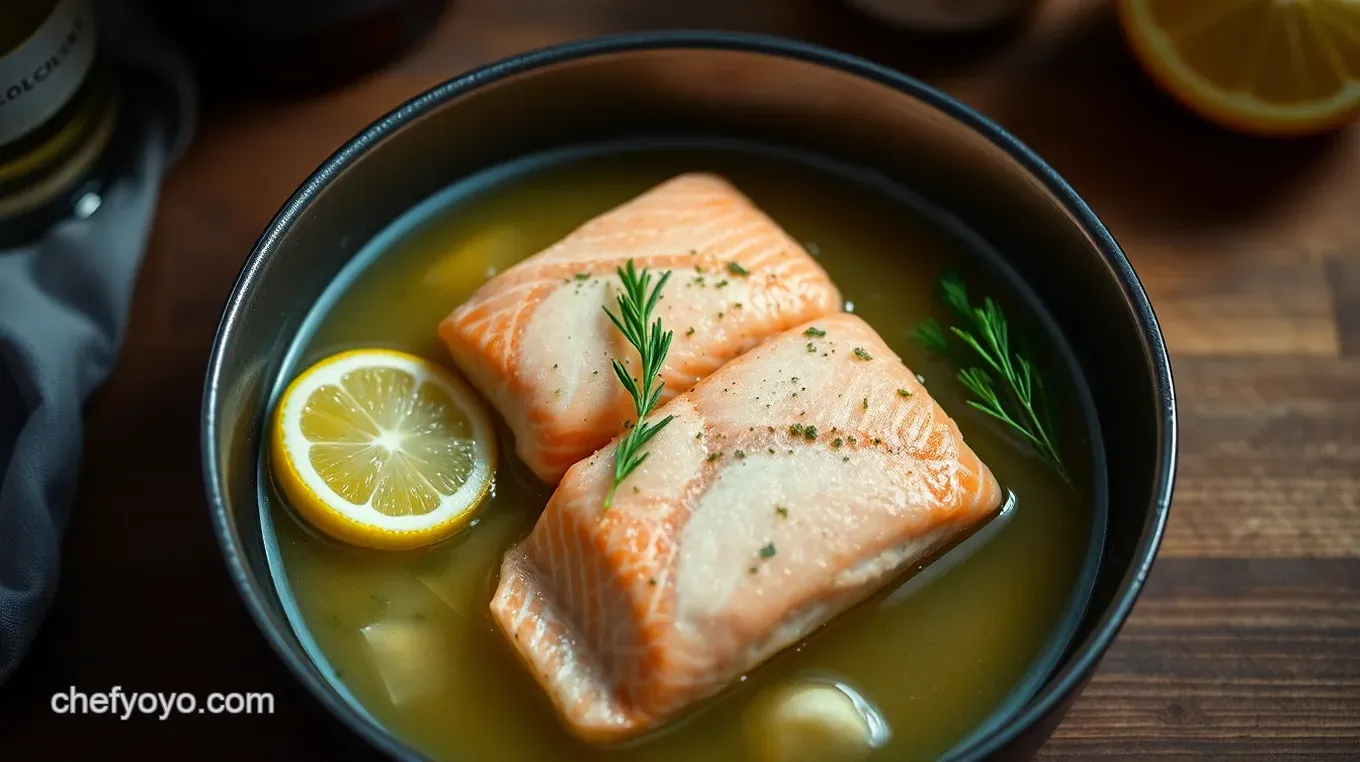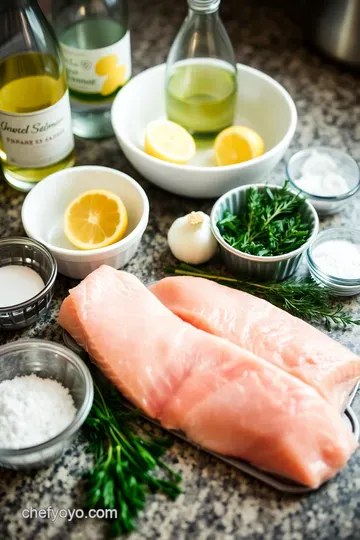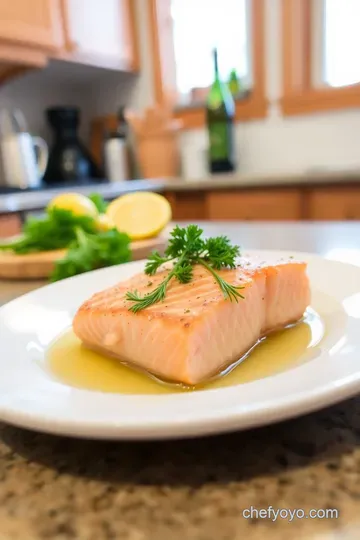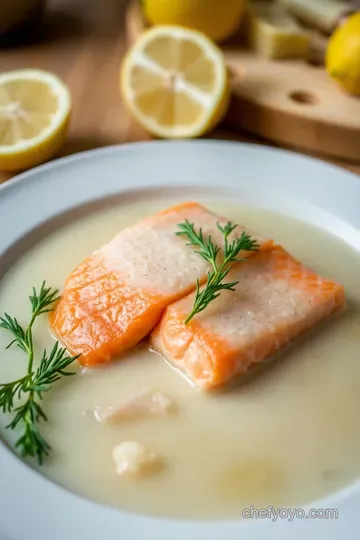Perfectly Poached Salmon: A Simple Guide to Culinary Excellence
Wondering how do I poach salmon? Discover a simple and delicious method for perfectly poached salmon, ideal for any occasion. Try it now!

- look into into Poaching: The Art of Perfectly Poached Salmon
- Essential Ingredients Guide to Cooking Salmon Fillet
- Mastering the Art of Poaching Salmon: A Fun Guide
- Expert Tips & Secrets for Poaching Salmon
- Perfect Presentation: Plating That Pops
- Storage & Make-Ahead Magic
- Creative Variations: Get Wild!
- Complete Nutrition Guide: Getting Down to the Numbers
- Frequently Asked Questions
- Recipe Card
look into into Poaching: The Art of Perfectly Poached Salmon
Oh my gosh, i still remember the first time i decided to tackle salmon. i was feeling fancy and a little adventurous in the kitchen.
Friends were coming over for a dinner party, and i wanted to impress. but there i was, staring at those beautiful salmon fillets in the grocery store, wondering, “ how do i poach salmon without turning it into a dry mess?” spoiler alert: it turned out to be one of the easiest and most delicious dishes i’ve ever made!
The truth is, poaching salmon isn’t rocket science. it’s actually a classic cooking technique that has been around for ages, historically celebrated for keeping fish moist and flavorful.
These days, with the health craze around seafood, poached salmon is super popular. it’s tender, flaky, and totally adaptable to whatever you're in the mood for.
Honestly, whether it's a chilled summer salad or a cozy winter dinner, this dish fits right in.
What You Need to Know Before You Cook
So, before we get cracking with how to poach salmon like a pro, let’s break down what makes this dish a go-to for many home cooks.
First off, the difficulty level is easy —if you can boil water, you can definitely handle this! you’ll need around 25 minutes from start to finish , which is perfect for busy weeknights or unexpected guests.
It serves two, but feel free to double the recipe if there are more mouths to feed.
Now, for cost considerations, salmon might be a bit pricier than other proteins, but trust me, it’s totally worth every penny when you feast on that buttery goodness.
Plus, it can yield a fab dish with some simple sides.
Why Poached Salmon Should Be Your Go-To
Let’s talk about why poached salmon is not just another recipe in your collection.
Health benefits : salmon is a rockstar when it comes to nutrition! packed with omega-3 fatty acids , it’s great for your heart and these bad boys can reduce inflammation.
With about 350 calories per serving, you can dig in without the guilt.
One word: versatility : whether it’s a weekend brunch with your friends or a fancy dinner party, this dish has you covered.
Dress it up with some fancy sauce or keep it simple with lemon and herbs. it pairs well with countless sides—think blanched veggies or a zesty salad.
Unique flavor profiles : unlike fried or baked fish, poaching allows the salmon to absorb flavors from the cooking liquid.
Fresh herbs, white wine, and citrus come together for a delightful taste adventure!
So, why not choose poached salmon over other fish dishes? well, it’s gentler on the protein and leaves you with a tender, flaky texture that’s hard to beat.
Plus, you can easily customize it with flavors you love—like citrus or asian-style with ginger and soy. trust me, once you whip this up, your friends will ask, “why haven’t we had this before?”
On to the Ingredients!
Now that you're pumped to make some poached salmon, we need to gather our goodies! Here’s what you’ll need:
- For the poaching liquid : Water, white wine, lemon slices, onion, herbs, and a sprinkle of salt.
- For the salmon : Just some fresh salmon fillets, seasoned simply with salt and pepper.
Together, these ingredients come together to create a lovely dish that’s as simple as it is satisfying.
Ready to dive deeper? Let's get into the nitty-gritty of actually cooking this delightful seafood treat!

Essential Ingredients Guide to Cooking Salmon Fillet
Hey there, food lovers! if you’re diving into the world of cooking salmon fillet, you’re in for a treat. seriously, there’s nothing like the delicate flakiness of poached salmon that just melts in your mouth.
Let's break it down together, making sure you’ve got all the essentials right at your fingertips.
Premium Core Components of Salmon Goodness
First things first, let’s talk ingredients . for that irresistibly tender salmon, you want to use the freshest fish you can find.
Aim for fillets that are bright in color and smell like the ocean—no funky fishy odor allowed! when you’re at the market, look for firm textures , and if you can press it and it springs back, you’re golden.
Now, about those measurements. For our poaching liquid, you'll need:
- 2 cups (500 ml) water
- 1 cup (250 ml) dry white wine (Sauvignon Blanc works like a charm)
- 1 small lemon, sliced
- 1 onion, quartered
- 1-2 sprigs of fresh dill or parsley (if you’re feeling fancy)
- Salt, to taste
Keep in mind that fish, like salmon , only lasts a few days in the fridge, so make sure to cook it or freeze it after purchase.
If you’ve got leftovers, they’re best eaten within two days.
Signature Seasoning Blend For Flavor Happiness
The beauty of poached salmon is its ability to pick up flavors. think of it like a sponge! i love adding lemon slices and fresh herbs to the poaching liquid.
This not only keeps the salmon juicy but also gives it that bright, zesty kick.
Try experimenting with different herbs. if dill isn’t your jam, tarragon offers a nice anise flavor. you can even throw in some crushed garlic or ginger for an asian twist.
Just remember, whatever you choose should complement the salmon, not overpower it.
Smart Substitutions in a Pinch
Okay, we've all had those kitchen moments where we realize we’re missing something crucial. but worry not! common alternatives can save the day.
If you’re out of white wine, chicken broth will do the trick. fresh herbs can be swapped with dried—just use about a third as much since dried herbs are more concentrated.
What if you don’t have salmon? trout or halibut can totally step in and be your wingman. each offers its own flavor profile but can be poached using the same method.
Now, that’s something to keep in your back pocket!
Kitchen Equipment Essentials for Every Home Cook
When it comes to kitchen equipment , there are a few must-haves for cooking salmon like a pro. a deep skillet or saucepan with a lid is ideal, as it keeps everything nice and snug while cooking.
Bonus tip: grab a slotted spatula to help you lift those delicate fillets without falling apart. if you’re a bit of a techie, a thermometer could be your best friend.
Aim for an internal temperature of 145° f ( 63° c) for that perfectly cooked salmon.
For storage, make sure to have some airtight containers handy. This keeps your leftovers fresh and ready for your next meal.
Time to look into In: Poaching Perfection Awaits
Now that you have your ingredients and tools ready, it’s time to practice the art of poaching salmon. remember, it’s all about keeping it low and slow.
As you simmer, the flavors marry together, and your kitchen starts smelling like a gourmet restaurant.
So, how do I poach salmon ? You’ll find it’s as simple as 1-2-3! Just simmer your poaching liquid, season those fillets, and let the magic happen for about 10- 15 minutes.
By the end of this journey, you’ll be dishing out not just a fish dinner , but an experience full of the best flavors and that oh-so-satisfying tenderness.
So grab your apron and let’s get cooking—your perfectly poached salmon is about to make a splash on your dinner table!

Mastering the Art of Poaching Salmon: A Fun Guide
If you’ve ever wondered how do i poach salmon , you’re in for a treat! poached salmon is not just tasty but also super easy to make.
Trust me, if you can turn on your stovetop, you can totally rock this dish.
Essential Preparation Steps
Alright, before we dive into the actual cooking, let's chat about mise en place . sounds fancy, right? it just means having everything ready to go before you start.
Chop up those herbs, measure out the wine, and have your seasonings lined up. this keeps your cooking smooth and stress-free.
Time management is key in any kitchen. While your poaching liquid is heating up on one burner, you can season your salmon on another. Multi-tasking is where it’s at!
Now, let’s talk safety . Always remember to use separate utensils when handling raw fish. Cross-contamination leads to the worst kind of kitchen disasters.
Step-by-Step Process
Now, let’s get into the nitty-gritty of making that perfect salmon!
-
Prepare the poaching liquid : grab a deep skillet and combine 2 cups of water , 1 cup of dry white wine , some lemon slices , and a quarter onion .
Sprinkle a bit of salt in there, too. stir it up!
-
Heat the liquid : get that mixture to a low simmer over medium heat. make sure it’s not boiling like a rollicking pot of spaghetti—that’s a no-no.
We want a gentle simmer for that tender salmon.
-
Season the Salmon : While that tasty liquid heats up, season your salmon fillets with salt and freshly ground black pepper. Bam! Easy peasy.
-
Poach the salmon : gently place those fillets into your simmering liquid. cover the skillet and let it do its thing for about 10- 15 minutes .
You’re looking for that salmon to be opaque and flake easily with a fork, meaning the internal temperature should hit 145° f ( 63° c) .
-
Serve : Carefully remove the salmon with a slotted spatula and place it on a pretty platter. Feel free to impress your friends with your skills.
Expert Techniques
Let’s up our game with a few expert techniques. when poaching, don’t overcrowd the pan. cooking one or two fillets at a time will help ensure even cooking .
You could even experiment with spices like peppercorns in the poaching liquid for an extra flavor boost.
When the timer goes off, take a peek. if it looks flaky and delicious, it’s time to eat! if not, give it a couple more minutes.
Remember, cooking isn’t an exact science; it’s all about your taste.
Success Strategies
So, what are the common mistakes we should avoid? one biggie is letting the liquid boil. if it bubbles like a cauldron, you’ll end up with tough salmon instead of that melt-in-your-mouth goodness we want.
Quality assurance is all about checking your salmon’s doneness. always use a thermometer if you're unsure—it's a game-changer! for those who love to prep in advance, chill your poached salmon and toss it in a refreshing salad later.
Conclusion: A Delicious Adventure Awaits
Alright, true story: the first time i tried poaching salmon, i was a bit nervous. but oh my gosh, when i finally plated it, i felt like gordon ramsay! it looked beautiful, smelled amazing, and tasted like a dream.
Now that you’ve got all this tasty info, you’re ready to tackle this dish. cooking salmon fillet using this simple poaching method is an everyday win.
So, bust out your skillet, grab some fresh fish salmon , and enjoy the journey of preparing this elegant yet simple meal.
And hey, if you're curious about expanding your seafood skills or looking for recipes for spring, stick around for my next section on additional information .
Trust me, there’s loads more deliciousness coming your way!

Expert Tips & Secrets for Poaching Salmon
Alright, let’s dive right into the good stuff! when you ask, "how do i poach salmon," it’s not just about dropping some fish into water and calling it a day.
Transitioning from a cooking novice to a kitchen ninja is about practicing a few chef secrets along the way.
First things first, use fresh ingredients. seriously, there’s no comparison. fresh salmon paired with fresh herbs will transform your dish from drab to fab.
And when it comes to time-saving techniques , multitasking is your best friend. while your poaching liquid is heating, season those salmon fillets.
This keeps everything flowing smoothly!
For flavor enhancement, i swear by adding citrus. a couple of lemon slices in the poaching liquid brighten it up and elevate the dish’s flavor profile.
Want a party in your mouth? toss in some dill or parsley. you'll thank me later!
Let’s be real about presentation; nobody wants to eat something that looks like it came from the bottom of a fish basket.
When plating, get a little artsy! place your fillet at a slight angle, drizzle some poaching liquid over it, and sprinkle fresh herbs on top.
Quick tip: color combinations matter. a vibrant green salad or some roasted carrots on the side makes for a feast that’s easy on the eyes — not just the stomach!
Perfect Presentation: Plating That Pops
Ah, plating techniques — this is where your meal becomes a masterpiece! when serving your poached salmon , think about height, color, and balance.
Imagine a simple but chic dish where the fish takes center stage, flanked by a lively side of green beans or some bright cherry tomatoes.
It’s all about that visual appeal !
Garnishing with a sprig of parsley or a twist of lemon makes everything look fancy, even if you didn’t plan it that way.
I've been known to add a sprinkle of smoked paprika just for that extra layer of flavor and color. you know what they say: if it doesn’t look good, it’s probably not that delicious!
Storage & Make-Ahead Magic
If you’re anything like me, you often wonder about storage . don't worry; poached salmon keeps well. after cooking, let the fillets cool and pop them in an airtight container.
They can stay fresh in your fridge for about three days . 🔥 reheating? just warm up in a skillet over low heat, or even better, toss it in a salad cold for a refreshing twist!
Now, if you’re thinking about making this dish ahead of time, you absolutely can! the flavors only deepen as they sit.
Just remember to stash it away in the fridge as soon as it's cool — safety first!
Creative Variations: Get Wild!
Feeling adventurous? let’s talk about creative variations . try swapping the traditional herbs for something spicy, like thai basil or ginger for a bit of a kick.
You can also modify for dietary needs, talking about lactose-free or gluten-free adaptations.
Seasonal twists are where it gets really exciting! Picture poaching with clementines in the winter , or dropping in fresh spring herbs – it makes your meal pop with seasonal flavor. 😂
And don’t forget about regional variations ! If you’re feeling extra fancy, add a jalapeño or capers to nod to coastal flavors.
Complete Nutrition Guide: Getting Down to the Numbers
Let’s face it, we all want to know how healthy our food is, right? a complete nutrition guide for our poached salmon runs roughly 350 calories, packed with 34g of protein .
Plus, those omega-3 fatty acids keep both your heart and brain happy! cleaning up your diet? this dish is a fantastic low-carb option, making it fitting for most meal plans, including keto or paleo.
Wrapping It All Up!
Now you have the scoop on cooking salmon fillet perfectly! with these pro tips, cool plating tricks, handy storage tips, creative variations, and nutrition info, you’re all set to impress your friends and fam.
So, the next time someone asks, “how do i poach salmon?” you’ll not only know the answer — you'll own the kitchen .
Pull that salmon from the pot with confidence, and enjoy a dinner that's not just good but unforgettable. remember, cooking should always be fun, and poached salmon? well, it’s just the beginning of a flavor adventure!
Frequently Asked Questions
How do I poach salmon without it falling apart?
To prevent your salmon from falling apart, ensure that you poach it gently in simmering liquid, not a rolling boil. Use a slotted spatula to handle the fish carefully when removing it from the pot, and consider poaching one or two fillets at a time for better control.
What type of pan is best for poaching salmon?
A deep skillet or saucepan with a lid works best for poaching salmon because it allows the fish to be submerged in the liquid without crowding. Make sure it’s large enough to accommodate the fillets while giving them ample space to cook evenly.
What can I use as a substitute for white wine in my poaching liquid?
If you prefer not to use white wine, vegetable or chicken broth is an excellent substitute. You can also use water with a splash of vinegar or lemon juice to mimic the acidity that wine provides.
How do I poach salmon so it stays moist?
To keep poached salmon moist, make sure not to overcook it. Cooking at a low simmer (around 170°F to 180°F) for about 10-15 minutes will ensure the salmon remains tender and juicy. You can also cover the skillet with a lid to trap steam, further aiding in moisture retention.
Can I store leftover poached salmon?
Absolutely! Leftover poached salmon can be stored in an airtight container in the fridge for up to three days. You can enjoy it cold in salads or sandwiches, or gently reheat it in the microwave to prevent it from drying out.
What are some tasty side dishes to serve with poached salmon?
Poached salmon pairs beautifully with a variety of sides. Consider serving it with steamed vegetables, a fresh salad dressed with lemon vinaigrette, or some fragrant rice pilaf. For a classic touch, add a side of buttered asparagus or a crisp cucumber salad as well!

Perfectly Poached Salmon: A Simple Guide to Culinary Excellence Card

⚖️ Ingredients:
- 2 cups (500 ml) water
- 1 cup (250 ml) dry white wine (such as Sauvignon Blanc)
- 1 small lemon, sliced
- 1 small onion, quartered
- 1-2 sprigs fresh dill or parsley (optional)
- Salt, to taste
- 2 salmon fillets (about 6 oz/170 g each)
- Freshly ground black pepper (to taste)
🥄 Instructions:
- Step 1: Combine water, white wine, lemon slices, onion, and herbs in the skillet; season with salt.
- Step 2: Bring the mixture to a simmer over medium heat; ensure it doesn’t boil vigorously.
- Step 3: While the liquid warms, season salmon fillets with salt and pepper.
- Step 4: Gently place salmon fillets in the simmering liquid and cover the skillet.
- Step 5: Cook for about 10-15 minutes, until the salmon is opaque and flakes easily with a fork (internal temperature should reach 145°F / 63°C).
- Step 6: Carefully remove the salmon using the slotted spatula and place it on a serving platter.
Previous Recipe: Homemade Corned Brisket: How to Make the Best Family Favorite
Next Recipe: Buttered Pickles: Easy Recipe for Creamy, Sweet Snacking Bliss
